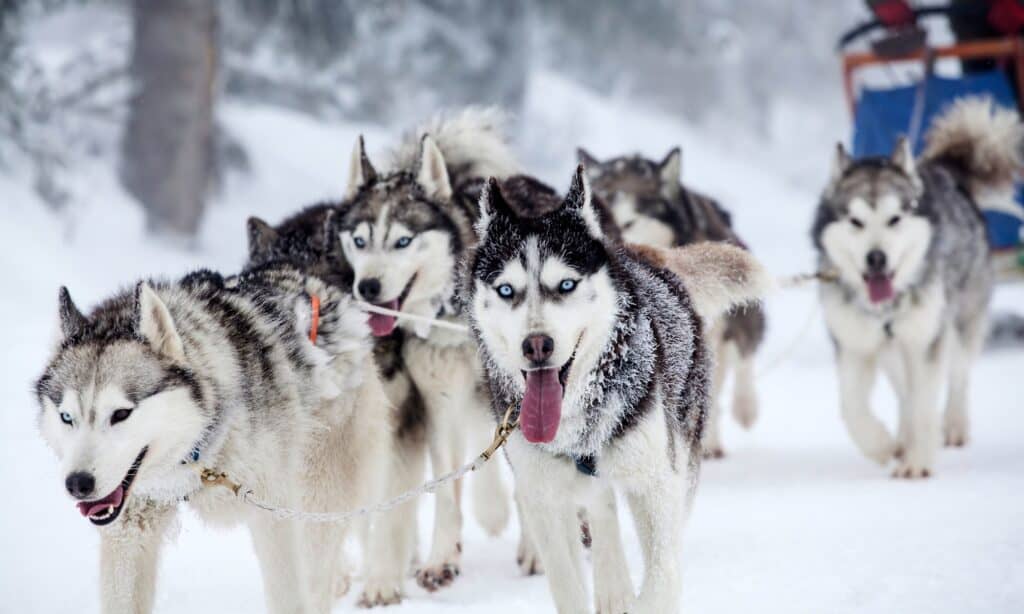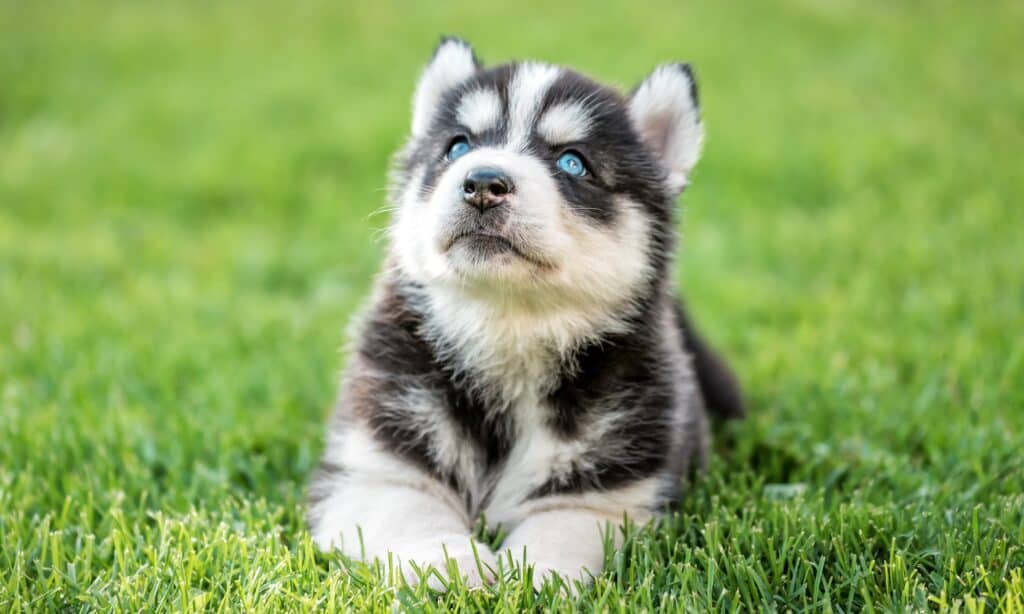Siberian huskies are one of the most adorable and unique breeds of dogs. They are also known as huskies or husky dogs. The name husky comes from the word “husky,” or “wolf” in English. Which is no coincidence considering they have a genetic connection from over 35,000 years ago to the Ancient Siberian wolf. While this can factor into the cause of blue eyes frequently occurring in huskies, what’s the real reason for these exotic eyes? What makes them so distinct aside from the contrast of their fur? Let’s find out!
No Blue In Their “Blue” Eyes
Siberian huskies do not have blue eyes, despite what some may believe. This doesn’t mean your whole life is a lie. Just this part is. Technically, their eyes lack pigment, which is the cause of their striking blue appearance. The light enters through the lens of the eyes and makes them appear this way. They are called blue by scientists and others to avoid confusion when discussing this topic. If one was to say “clear eyes” when talking about them, it could easily be confused with an eye drop commercial. Around 5% of the dog population have blue eyes, so how do 40% of huskies have them? There are some theories as to why their eyes are blue, ranging from their relation to the Ancient Siberian wolf to the cold Siberian weather.

©iStock.com/8213erika
The Genetics Behind It
How did they find that the husky shared a genetic connection with the Ancient Siberian Wolf? They traced it through their genome, which is the complete set of DNA found in a cell. This is also how they discovered that their blue eyes are caused by a mutation near the ALX4 gene, which is part of the 18 chromosomes found in dogs. The mutation causes a lack of melanin. It’s important to know that melanin is responsible for several things. Melanin determines the primary color of the dog’s fur coat, and it can cause dark pigments in the dog’s skin. A veterinarian should evaluate drastic skin changes or anything you’re unsure about, just in case. The word melanin comes from the Greek word μῆλον (mēlon), meaning “black.” The more melanin, the darker the color or pigment. For example, brown eyes in dogs mean more melanin. This explains why the absence of it causes light-colored eyes, such as the Siberian Huskies. It typically determines fur color too, but this does not apply to huskies. Their fur and eyes aren’t connected as most dogs are. Lastly, melanin also offers protection against harmful sun rays.
Common Eye Conditions Occurring In Siberian Huskies
With the given information above, it is easy to assume that eye problems are caused by a dog having blue eyes. That, luckily, is false. However, huskies are prone to a few eye conditions like juvenile cataracts, progressive retinal atrophy, heterochromia, and corneal atrophy.
Juvenile cataracts affect up to 10% of the huskies. The ages of dogs affected are roughly six to twelve months. Sometimes it can occur at just three months old. Having cataracts will block light from entering the eye lens in your puppy. If this isn’t addressed, the pup can go blind. Untreated, it can have severe consequences, such as the dog developing glaucoma, which is excruciatingly painful for them.
Progressive retinal atrophy is a degenerative disease that affects photoreceptor cells. As these cells deteriorate over time, the dog will go blind. The condition is inherited, meaning it can be passed from one generation to another. It takes two bad genes, one from each parent, to give to their offspring. This can lead to purebred dog breeds having more risk than mixed breeds in acquiring this condition.
Corneal dystrophy is used to cover several conditions that cause the corneas to become cloudy. There are three main types: stromal, epithelial, and endothelial. Siberian huskies tend not to have the most severe form of these, which is good news for husky owners.
Epithelial corneal dystrophy occurs in the superficial layers of the cornea. Often, this disease does not cause many noticeable symptoms, but it can cause sensitivity to light resulting in the dog squinting and eye pain.
Stromal corneal dystrophy is a condition where the cornea’s middle layer is damaged. This damages vision and can present as a ring around the outside border of the cornea. It’s unknown what causes it, but it can be corrected with surgery.
Endothelial corneal dystrophy develops in the deep layer of the cornea. The signs are often hard to detect at first and are easily missed. It can cause dogs’ eyes to develop ulcers and lead to vision loss.
Heterochromia is a condition affecting the iris of the eye. There are many variations of it, such as complete heterochromia, where both eyes have two different colors, and partial heterochromia, where one eye has two different colors and the other eye can be a different color than its partner. The most common type is called sectoral heterochromia, where one iris has a different color than the other. If your dog suddenly has eye changes, especially if their eyes start looking cloudy or one eye appears lighter, you may need to consult a vet.
Puppy’s Eye Color

©iStock.com/vovashevchuk
Some owners or breeders want blue-eyed puppies because they are often sought after, so they attempt to feed pregnant dogs certain things or give puppies a gimmicky supplement. These are not helpful and do not work. There is no magic way to guarantee a dog will have blue eyes. The only thing that can decide a puppy’s eye color is genetics. Never feed or give supplements to your dog without consulting a veterinarian first. You could do harm unintentionally to your pets, and you wouldn’t want that!
Since most puppies are born with blue eyes, when can you expect their eyes to change to their permanent color? Typically eight to ten weeks, but up to six months is the latest. If you notice a change in eye color after this age, you should speak to your veterinarian to rule out any of the known eye problems. It is recommended that Siberian huskies see a veterinarian once or twice a year. This is important because they can catch things that dog owners might not have even noticed or been able to check for themselves, such as blood work.
Of course, if you see anything with their eyes that seems out of the ordinary and need a better look, take them outside. It’s less strain on their eyes than using a flashlight and will give you great visualization. This can be helpful, so you know exactly what to ask about at your dog’s checkups.
- Premium supplement for nursing dogs
- Stimulates milk production
- Contains antioxidants
- Can be used for dogs and cats
Other Blue-Eyed Dogs
Though blue-eyed dogs are uncommon, there are other breeds of dogs with this beautiful eye color. While the Siberian husky is most likely to have these traits, some other dogs can, including:
- Border Collie
- Australian Shepherd
- Weimaraner
- Cardigan Welsh Corgi
- Dalmatians
- Great Dane
- Catahoula Leopard Dog
- Alaskan Klee Kai
- Pit Bull
The photo featured at the top of this post is © iStock.com/format35
FAQs (Frequently Asked Questions)
What other colors of eyes can huskies have?
Even though blue eyes are prevalent, with 40% of Siberian huskies having them, there is also a 40% chance of their eyes being brown. 15% have two different colored eyes, and 5% account for dogs with two colors in one iris. Green eyes are extremely rare in dogs.
Can husky's eyes change colors as humans can?
Not once they are past the age of six months, their eyes shouldn’t change color at all. If they do, take them as soon as possible for an eye exam.
When do husky puppies open their eyes?
10 to 14 days is around the time they open their eyes, but they won’t be able to see clearly until later.
Can Huskies see in the dark?
They don’t have night vision; however, they can see in five times less light than humans can. This is because their pupils are larger than ours and can let more light pass through. Huskies also have more light-sensitive rods in their eyes, which is how eyes perceive light. An additional eye structure in their eye allows for light to reflect into the retina. This is also why when you take a flash photo of your dog, they may have different colored eyes. It’s because of the way that light reflects on them. It causes them to glow red, yellow, or other colors.
Thank you for reading! Have some feedback for us? Contact the AZ Animals editorial team.







